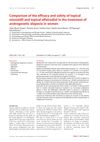TLDR Minoxidil binds to hair pigment but doesn't affect hair growth.
The study investigated the interaction of minoxidil with pigment in hair follicle cells, using radiolabeled minoxidil in mouse vibrissae follicles. It was found that minoxidil and its sulfate form accumulated in pigmented areas of the follicles, particularly in melanocytes and areas with high melanin concentrations. Despite the lower uptake in unpigmented follicles, minoxidil stimulated proliferation and differentiation in both pigmented and unpigmented follicles. The binding of minoxidil to melanin served as a targeting mechanism to pigmented follicles, but this interaction did not have a significant impact on hair growth. The study highlighted that drug measurements in hair could be influenced by pigmentation.
January 2022 in “Wiadomości lekarskie (Warsaw Poland)” MSM reduces hair loss and promotes hair growth in male mice.
The herbal extract CS-10-H significantly promotes hair growth in mice.
 56 citations
,
April 2007 in “Journal der Deutschen Dermatologischen Gesellschaft”
56 citations
,
April 2007 in “Journal der Deutschen Dermatologischen Gesellschaft” Minoxidil works better for female hair loss than alfatradiol, both safe.
 March 2005 in “Journal of The American Academy of Dermatology”
March 2005 in “Journal of The American Academy of Dermatology” Two cosmetic lotions improved hair growth and had better cosmetic effects than 2% minoxidil.
 15 citations
,
April 2001 in “Journal of Dermatological Science”
15 citations
,
April 2001 in “Journal of Dermatological Science” KF19418 promotes hair growth similarly to minoxidil but is not better in live mice.
1 citations
,
January 1991 in “Journal of Dermatological Treatment” Minoxidil doesn't change scalp oil production.
19 citations
,
October 1989 in “PubMed” Minoxidil helps hair growth by being sulfated in hair follicles.
12 citations
,
May 1988 in “Journal of the American Academy of Dermatology” Both 2% minoxidil gel and solution effectively increase hair growth in men with early baldness.
 57 citations
,
July 1987 in “Journal of The American Academy of Dermatology”
57 citations
,
July 1987 in “Journal of The American Academy of Dermatology” Stopping minoxidil treatment resumes balding; continuous use needed for results.



